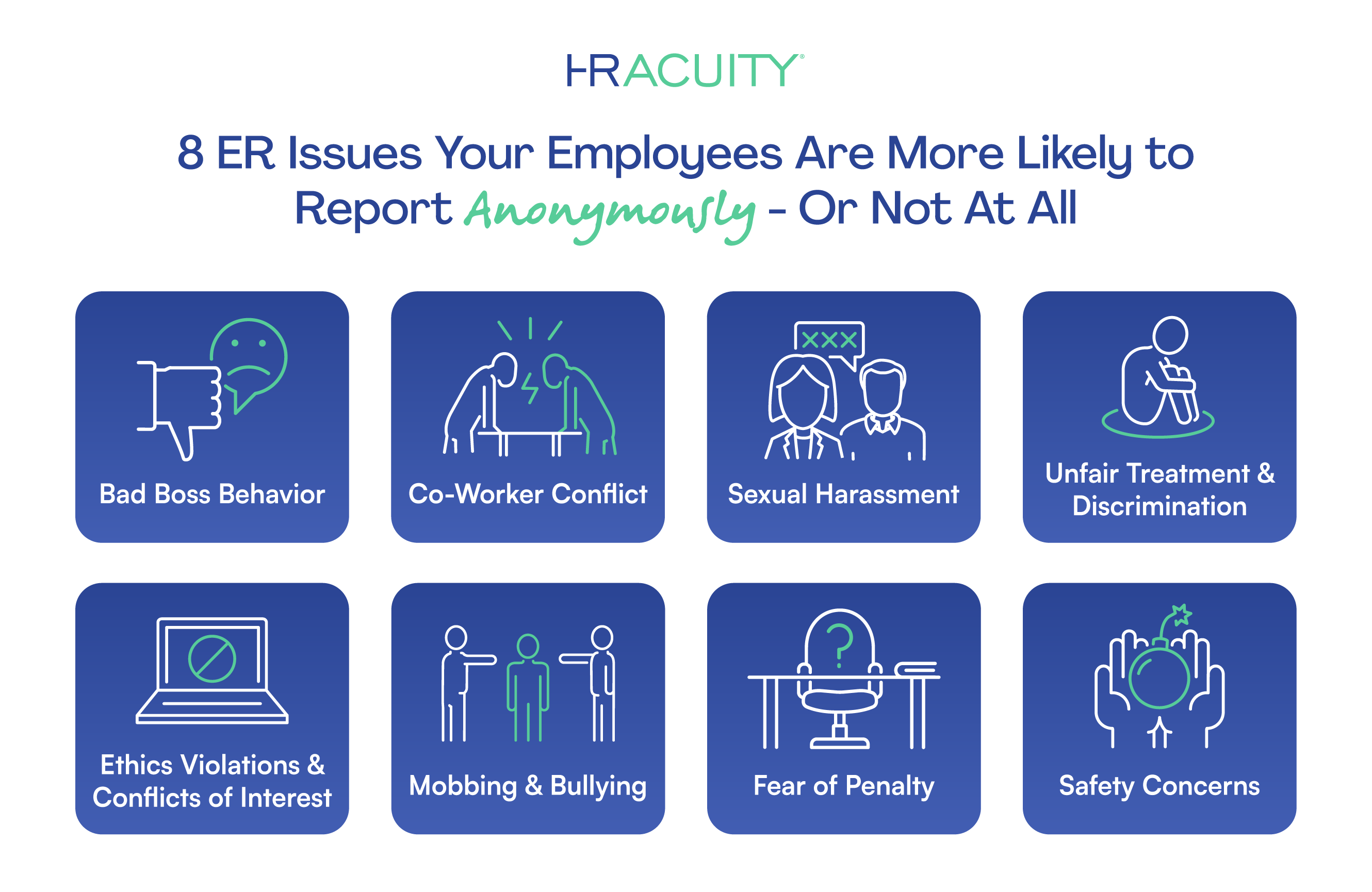Guess what? What you don’t know actually CAN hurt you and your organization. Aside from leaving an organization vulnerable to future lawsuits, unreported harassment kills culture, fuels turnover and drains productivity. Unfortunately, there’s a growing gap between employees experiencing misconduct at work and those who actually report it.
According to HR Acuity’s most recent Workplace Harassment and Misconduct Insights study, 56% of employees have experienced or witnessed bad behavior in the workplace, yet only 64% of those employees have reported it. Our data also reveals the main reasons behind the lack of reporting – a full 39% of employees aren’t confident their issues will be addressed fairly if they do come forward, and 46% are uncertain and fear retaliation.
According to Ethisphere, it’s getting worse with the youngest working generation too. Gen Z was the age group that was least likely to answer “yes” to the question of whether they reported workplace misconduct: 43.6%, compared with 45.5% of millennials, 53.5% of Gen Xers, and 50.3% of boomers.
Ethisphere further reports that 55.5% of the Gen Z respondents who witnessed workplace misconduct said they did not report it because they didn’t believe corrective action would be taken. 47.1% said they worried about retaliation for reporting misconduct. 41.2% said they feared they wouldn’t remain anonymous after reporting. 40.1% said they didn’t feel comfortable reporting on employees who were senior to them. 21% said they were afraid that reporting misconduct would hurt their team members.
It’s pretty obvious Gen Z doesn’t trust the system.
Can you blame them? They’ve entered the workforce at a time when we see headlines like “McDonald’s Has a Real Sexual Harassment Problem.” Turns out McDonald’s executives have a real sexual harassment problem. Steve Easterbrook, their former CEO was fired and required to pay back $105 million in cash and equity awards to settle his lawsuit. Shortly after, David Fairhurst, their former Chief People Officer was fired and sued by the board because he should have done more about the toxic culture happening under his watch.
The truth is, we have to take the lead on building trust. Not only is it our job to make employees feel safe at work, but it’s our job to design, implement and enforce transparent, accountable processes that build employee confidence. The good news is that we have the power to improve the safety and security of reporting processes because the tools for doing so just keep getting better.
Spending some time understanding and implementing the power of a truly anonymous issue reporting tool can improve employee confidence in your process, help you capture issues early on, and of course, keep your organization compliant. Note – the best anonymous tools build trust and transparency. They do so by offering the following non-negotiables:
- The platform allows employees to communicate with HR in an easily accessible and safe way when something goes wrong at work.
- Employees can access real time updates on the progress and resolution of their concern within a secure portal.
Not sure what issues you may be in the dark about? Here are just eight issues your employees are more likely to report anonymously:

- Bad boss behavior: There’s a good reason they made two “Horrible Bosses” movies; some people are not well-behaved when they wield power. Unfortunately, reporting your own boss probably tops the list of anxiety inducing situations due to fear of retaliation. Anonymous reporting is especially important when an individual cannot go to their immediate supervisor about the problem because that person is the problem!
- Co-worker conflict: Team chemistry is critical. When an issue arises between co-workers there is more at risk than just the individual who is on the receiving end. Reporting a co-worker can inadvertently create sides and divide a team. Overnight a two person problem can become a twenty person problem as the rumor mill starts cranking. Not only does it destroy productivity, but it also damages your culture and puts you at risk for “group quitting.” Anonymous reporting can help increase the chances the issue stays contained by repositioning it from public trial to private investigation.
- Sexual harassment: While #MeToo has improved overall awareness, victims still under- report by a wide margin. According to the American Psychological Association, in organizations led by women 56% of sexual harassment victims report it, while in organizations led by men 39% will report. The truth is, victims still fear retaliation, and research reveals they’re not paranoid. Recent research published in Organization Science reveals that some people – including managers – may be morally biased against sexual harassment victims and actually favor accused perpetrators. Anonymous reporting goes a long way to help victims feel safer about speaking up. So can revisiting forced arbitration agreements.
- Unfair treatment & Discrimination: We could write an entire statistical listicle around the prevalence of discrimination claims filed with the EEOC. These claims leave your organization wide open, and there are no shortages of -isms and phobias you need to identify and handle before they escalate. Sexism, racism, ageism, ableism, transphobia, xenophobia, fatphobia and the list goes on. But the truth is, fear of retaliation is what keeps early reporting low. Anonymous reporting helps your organization identify and properly deal with intolerant people before they metastasize into workplace cancers.
- Ethics violations & fraud & conflicts of interest: Turns out good people don’t appreciate it when others don’t play by the rules. Whistleblowers are justice seekers and they’re your eyes and ears when it comes to nuanced misconduct that is hard to catch. The catch is, they’re more likely to help you if they can do it anonymously. It’s not a cinematic preference when whistleblower videos include pixelated faces and auto-tuned voices. They actually need anonymity for a whistleblower process to actually work. Anonymous reporting sends a signal to everyone about accountability and gives them a safe way to implement that organizational value.
- Mobbing & Bullying: While we’re pretty familiar with what a bully is, mobbing is a term you may not be familiar with yet. In nature, mobbing describes animal predatory behavior. At work, it describes groups of coworkers targeting a co-worker to humiliate, harass, and terrorize them with a goal to make them quit. Our human instinct toward conformity might be at the root, but all too often mobbing is a sign of something more complex. Jealousy of high-performers, group-based goals, prejudice or discrimination, high workloads and low psychological safety can all feed group bullying. Having a target on your back is enough to make anyone fear speaking up – even if they’re trying to be an ally. Anonymous reporting makes it more likely that the victim will benefit from more eye witnesses, as the group pressure to stay quiet mounts.
- Fear of nuanced penalty: People who take maternity or paternity leave, or otherwise use their benefits that include time away from work can often fear quiet retaliation from their teams and their managers due to the perceived (and often real) stress their absence puts on co-workers. Anonymous reporting allows these employees to be heard if indeed they experience retaliation when they return.
- Safety concerns: Everything. Everywhere. All at Once. Great movie, impossible job expectation. You simply cannot see every safety risk that lurks within your organization – especially if people are located in multiple places. Anonymous reporting makes it easy for employees to report unsafe work conditions without fear of retaliation from their teams or their managers.
We can’t control everything bad that can happen at work, but we can and should do everything in our power to help employees feel safe and confident that they will be heard, believed and protected when something does go wrong.
To learn more about how you can provide a transparent and trustworthy space for your employees to come forward, book a demo to see Speakfully powered by HR Acuity.



